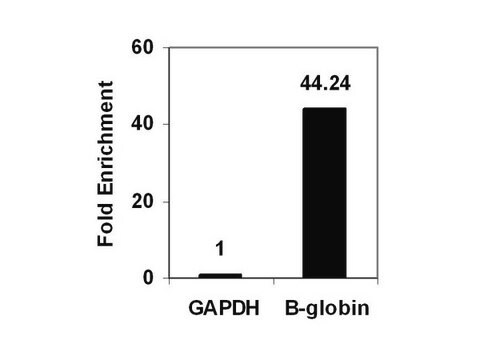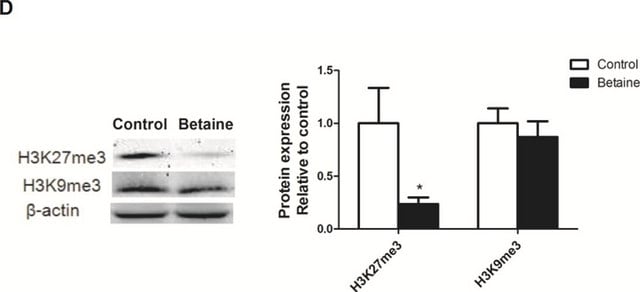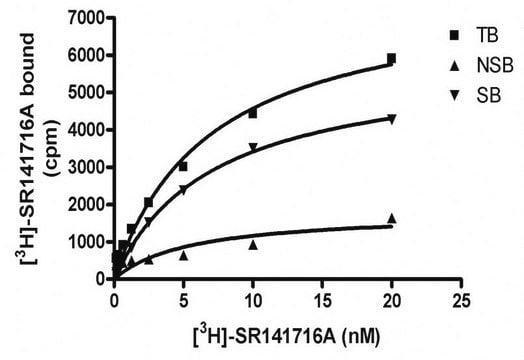17-10108
ChIPAb+ Dimethyl-Histone H3 (Lys27) - ChIP Validated Antibody and Primer Set, rabbit monoclonal
culture supernatant, from rabbit
別名:
H3K27me2, Histone H3 (di methyl K27), H3 histone family, member M, H3 histone, family 2, histone 2, H3c, histone cluster 2, H3c
ログイン組織・契約価格を表示する
すべての画像(4)
About This Item
UNSPSCコード:
12352203
eCl@ss:
32160702
NACRES:
NA.52
おすすめの製品
由来生物
rabbit
品質水準
抗体製品の状態
culture supernatant
クローン
monoclonal
化学種の反応性
vertebrates
メーカー/製品名
ChIPAb+
Upstate®
テクニック
ChIP: suitable
cell based assay: suitable
immunoprecipitation (IP): suitable
western blot: suitable
アイソタイプ
IgG
NCBIアクセッション番号
UniProtアクセッション番号
輸送温度
dry ice
関連するカテゴリー
詳細
All ChIPAb+ antibodies are individually validated for chromatin precipitation, every lot, every time. Each ChIPAb+ antibody set includes control primers (tested every lot by qPCR) to biologically validate your IP results in a locus-specific context. The qPCR protocol and primer sequences are provided, allowing researchers to validate ChIP protocols when using our antibody in their chromatin context. Each set also includes a negative control antibody to ensure specificity of the ChIP reaction.
The ChIPAb+ Dimethyl-Histone H3 (Lys27) set includes the Dimethyl-Histone H3 (Lys27) antibody, a negative control rabbit supernatant, and qPCR primers which amplify a 110 bp region of human β-globin promoter. The Dimethyl-Histone H3 (Lys27) and negative controls are supplied in a scalable "per ChIP" reaction size and can be used to functionally validate the precipitation of Dimethyl-Histone H3 (Lys27)-associated chromatin.
The ChIPAb+ Dimethyl-Histone H3 (Lys27) set includes the Dimethyl-Histone H3 (Lys27) antibody, a negative control rabbit supernatant, and qPCR primers which amplify a 110 bp region of human β-globin promoter. The Dimethyl-Histone H3 (Lys27) and negative controls are supplied in a scalable "per ChIP" reaction size and can be used to functionally validate the precipitation of Dimethyl-Histone H3 (Lys27)-associated chromatin.
Histones are highly conserved proteins that serve as the structural scaffold for the organization of nuclear DNA into chromatin. The four core histones, H2A, H2B, H3, and H4, assemble into an octamer (2 molecules of each). Subsequently, 146 base pairs of DNA are wrapped around the octamer, forming a nucleosome. Histones are modified post-translationally by the actions of enzymes in both the nucleus and cytoplasm. These modifications regulate DNA transcription, repair, recombination, and replication. The most commonly studied modifications are acetylation, phosphorylation, methylation, and ubiquitination. These modifications can alter local chromatin architecture, or recruit trans-acting factors that recognize specific histone modifications (the "histone code" hypothesis). The modifications occur predominantly on the N-terminal and C-terminal tails that extend beyond the nucleosome core particle. Histone H3 is methylated at Lys27 by EZH2, and and overexpression of EZH2 has been associated with both breast and prostate cancers. Methylation of H3K27 is involved in X chroosome inactivation, imprinting, circadian rhythms, and stem cell maintenance. H3K27me2 is a marker of classical heterochromatin.
特異性
Broad species cross-reactivity expected, based on sequence identity in most species.
This antibody recognizes Histone H3 dimethylated on Lys27.
免疫原
Epitope: Dimethyl Lys27
Peptide containing the sequence (ARme2KSA) in which me2 corresponds to dimethyl lysine at residue 27 of human histone H3.
アプリケーション
Research Category
エピジェネティクス及び核内機能分子
エピジェネティクス及び核内機能分子
Research Sub Category
ヒストン
ヒストン
Chromatin Immunoprecipitation:
Representative lot data.
Sonicated chromatin prepared from HeLa cells (1 X 10E6 cell equivalents per IP) were subjected to chromatin immunoprecipitation using either 2 µL of Negative Control Supernatant or 2 µL of Anti-dimethyl-Histone H3 (Lys27) and the Magna ChIP® A Kit (Cat. # 17-610).
Successful immunoprecipitation of dimethyl-Histone H3 (Lys27) associated DNA fragments was verified by qPCR using ChIP Primers, human β-globin as a positive locus, and GAPDH promoter primers as a negative locus (Please see figures). Data is presented as percent input of each IP sample relative to input chromatin for each amplicon and ChIP sample as indicated.
Please refer to the EZ-Magna ChIP A (Cat. # 17-408) or EZ-ChIP (Cat. # 17-371) protocol for experimental details.
Western Blot Analysis:
Representative lot data.
A 1:1000-1:5000 dilution of a previous lot detected dimethyl-Histone H3 in acid extracted proteins from HeLa cells, but did not detect unmethylated recombinant Histone H3 (Catalog # 14-494).
Recombinant Histone H3 (lane 1) and HeLa cell acid precipitate (lane 2) were resolved by electrophoresis, transferred to nitrocellulose and probed with anti-dimethyl-Histone H3 (Lys27) (1:1000 dilution).
Proteins were visualized using a goat anti-rabbit secondary antibody conjugated to HRP and a chemiluminescence detection system.
Arrow indicates dimethyl-histone H3 (~17 kDa) (Please see figures).
Peptide Inhibition Assay (PIA):
Representative lot data.
0.5-2 μM of histone H3 peptides containing dimethyl-Lys27 abolished detection of histone H3 by anti-dimethyl-Histone H3 (Lys27) (1:1000 dilution) in immunoblots of acid extracted proteins from HeLa cells.
Acid extracted proteins from HeLa cells were resolved by electrophoresis, transferred to nitrocellulose and probed with anti-dimethyl-Histone H3 (Lys27) (lane 1) or anti-dimethyl-Histone H3 (Lys27) preabsorbed with 0.5 mM of histone H3 peptides containing the following modifications:
Lane 2: dimethyl-lysine 23
Lane 3: dimethyl-lysine 27
Lane 4: dimethyl-lysine 9
A 1:1000 dilution of the primary antibody was used.
Proteins were visualized using a goat anti-rabbit secondary antibody conjugated to HRP and a chemiluminescence detection system.
Arrow indicates dimethyl-histone H3 (~17 kDa) (Please see figures).
Representative lot data.
Sonicated chromatin prepared from HeLa cells (1 X 10E6 cell equivalents per IP) were subjected to chromatin immunoprecipitation using either 2 µL of Negative Control Supernatant or 2 µL of Anti-dimethyl-Histone H3 (Lys27) and the Magna ChIP® A Kit (Cat. # 17-610).
Successful immunoprecipitation of dimethyl-Histone H3 (Lys27) associated DNA fragments was verified by qPCR using ChIP Primers, human β-globin as a positive locus, and GAPDH promoter primers as a negative locus (Please see figures). Data is presented as percent input of each IP sample relative to input chromatin for each amplicon and ChIP sample as indicated.
Please refer to the EZ-Magna ChIP A (Cat. # 17-408) or EZ-ChIP (Cat. # 17-371) protocol for experimental details.
Western Blot Analysis:
Representative lot data.
A 1:1000-1:5000 dilution of a previous lot detected dimethyl-Histone H3 in acid extracted proteins from HeLa cells, but did not detect unmethylated recombinant Histone H3 (Catalog # 14-494).
Recombinant Histone H3 (lane 1) and HeLa cell acid precipitate (lane 2) were resolved by electrophoresis, transferred to nitrocellulose and probed with anti-dimethyl-Histone H3 (Lys27) (1:1000 dilution).
Proteins were visualized using a goat anti-rabbit secondary antibody conjugated to HRP and a chemiluminescence detection system.
Arrow indicates dimethyl-histone H3 (~17 kDa) (Please see figures).
Peptide Inhibition Assay (PIA):
Representative lot data.
0.5-2 μM of histone H3 peptides containing dimethyl-Lys27 abolished detection of histone H3 by anti-dimethyl-Histone H3 (Lys27) (1:1000 dilution) in immunoblots of acid extracted proteins from HeLa cells.
Acid extracted proteins from HeLa cells were resolved by electrophoresis, transferred to nitrocellulose and probed with anti-dimethyl-Histone H3 (Lys27) (lane 1) or anti-dimethyl-Histone H3 (Lys27) preabsorbed with 0.5 mM of histone H3 peptides containing the following modifications:
Lane 2: dimethyl-lysine 23
Lane 3: dimethyl-lysine 27
Lane 4: dimethyl-lysine 9
A 1:1000 dilution of the primary antibody was used.
Proteins were visualized using a goat anti-rabbit secondary antibody conjugated to HRP and a chemiluminescence detection system.
Arrow indicates dimethyl-histone H3 (~17 kDa) (Please see figures).
This ChIPAb+ Dimethyl-Histone H3 (Lys27) -ChIP Validated Antibody & Primer Set conveniently includes the antibody & the specific control PCR primers.
包装
25 assays per set. Recommended use: ~2 μL of antibody per chromatin immunoprecipitation (dependent upon biological context).
品質
Chromatin Immunoprecipitation:
Sonicated chromatin prepared from HeLa cells (1 X 10E6 cell equivalents per IP) were subjected to chromatin immunoprecipitation using either 2 µL of Negative Control Supernatant or 2 µL of Anti-dimethyl-Histone H3 (Lys27) and the Magna ChIP® A Kit (Cat. # 17-610).
Successful immunoprecipitation of dimethyl-Histone H3 (Lys27)-associated DNA fragments was verified by qPCR using ChIP Primers, human β-globin (Please see figures).
Please refer to the EZ-Magna ChIP A (Cat. # 17-408) or EZ-ChIP (Cat. # 17-371) protocol for experimental details.
Sonicated chromatin prepared from HeLa cells (1 X 10E6 cell equivalents per IP) were subjected to chromatin immunoprecipitation using either 2 µL of Negative Control Supernatant or 2 µL of Anti-dimethyl-Histone H3 (Lys27) and the Magna ChIP® A Kit (Cat. # 17-610).
Successful immunoprecipitation of dimethyl-Histone H3 (Lys27)-associated DNA fragments was verified by qPCR using ChIP Primers, human β-globin (Please see figures).
Please refer to the EZ-Magna ChIP A (Cat. # 17-408) or EZ-ChIP (Cat. # 17-371) protocol for experimental details.
ターゲットの説明
~17 kDa
物理的形状
Unpurified supernatant
Anti-Dimethyl-Histone H3 (Lys27) (rabbit monoclonal). One vial containing 50 µL of cultured supernantant in 0.05% sodium azide. Store at -20°C.
Negative Control Supernatant. One vial containing 100 µL of rabbit cultured supernatant in 0.05% sodium azide. Store at -20°C.
ChIP Primers, human β-globin. One vial containing 75 μL of 5 μM of each primer specific for the human β-globin promoter. Store at -20°C.
FOR: AGG ACA GGT ACG GCT GTC ATC
REV: TTT ATG CCC AGC CCT GGC TC
Negative Control Supernatant. One vial containing 100 µL of rabbit cultured supernatant in 0.05% sodium azide. Store at -20°C.
ChIP Primers, human β-globin. One vial containing 75 μL of 5 μM of each primer specific for the human β-globin promoter. Store at -20°C.
FOR: AGG ACA GGT ACG GCT GTC ATC
REV: TTT ATG CCC AGC CCT GGC TC
保管および安定性
1 year at -20°C from date of shipment
Handling Recommendations: Upon receipt, and prior to removing the cap, centrifuge the vial and gently mix the solution. Aliquot into microcentrifuge tubes and store at -20°C. Avoid repeated freeze/ thaw cycles, which may damage IgG and affect product performance.
Handling Recommendations: Upon receipt, and prior to removing the cap, centrifuge the vial and gently mix the solution. Aliquot into microcentrifuge tubes and store at -20°C. Avoid repeated freeze/ thaw cycles, which may damage IgG and affect product performance.
アナリシスノート
Control
Includes negative control rabbit supernatant and primers specific for human β-globin promoter.
Includes negative control rabbit supernatant and primers specific for human β-globin promoter.
法的情報
MAGNA CHIP is a registered trademark of Merck KGaA, Darmstadt, Germany
UPSTATE is a registered trademark of Merck KGaA, Darmstadt, Germany
免責事項
Unless otherwise stated in our catalog or other company documentation accompanying the product(s), our products are intended for research use only and are not to be used for any other purpose, which includes but is not limited to, unauthorized commercial uses, in vitro diagnostic uses, ex vivo or in vivo therapeutic uses or any type of consumption or application to humans or animals.
保管分類コード
10 - Combustible liquids
適用法令
試験研究用途を考慮した関連法令を主に挙げております。化学物質以外については、一部の情報のみ提供しています。 製品を安全かつ合法的に使用することは、使用者の義務です。最新情報により修正される場合があります。WEBの反映には時間を要することがあるため、適宜SDSをご参照ください。
Jan Code
17-10108:
試験成績書(COA)
製品のロット番号・バッチ番号を入力して、試験成績書(COA) を検索できます。ロット番号・バッチ番号は、製品ラベルに「Lot」または「Batch」に続いて記載されています。
Tao Gui et al.
Cell death and differentiation, 28(12), 3316-3328 (2021-06-28)
Endometrial cancer (EC) is the most common gynecological malignancy worldwide. However, the molecular mechanisms underlying EC progression are still largely unknown, and chemotherapeutic options for EC patients are currently very limited. In this study, we found that histone methyltransferase EZH2
ライフサイエンス、有機合成、材料科学、クロマトグラフィー、分析など、あらゆる分野の研究に経験のあるメンバーがおります。.
製品に関するお問い合わせはこちら(テクニカルサービス)








